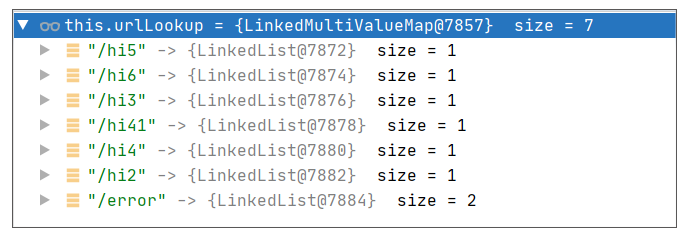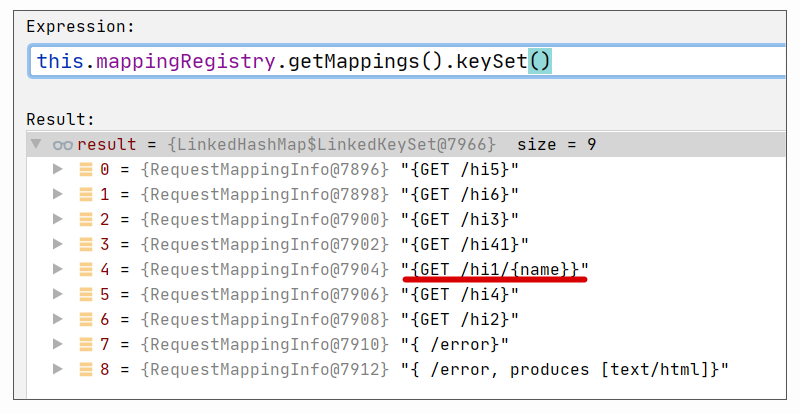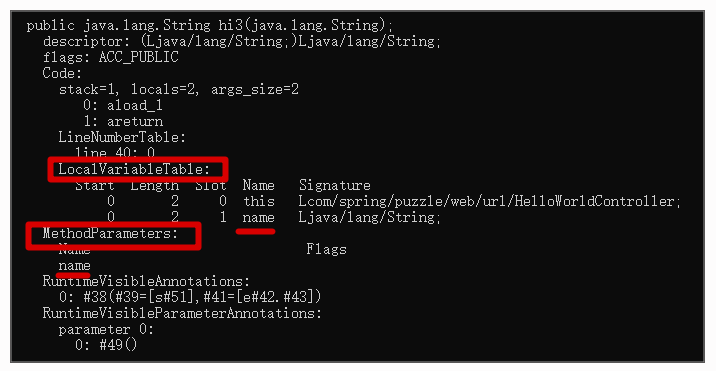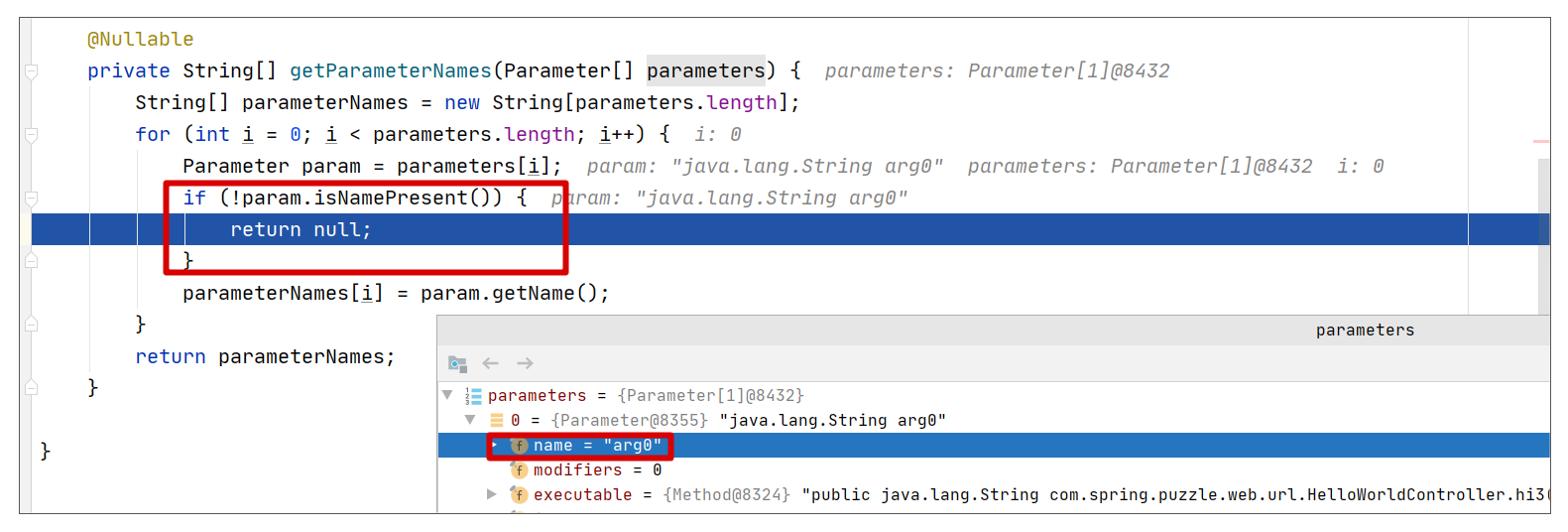上一章节我们讲解了各式各样的错误案例,这些案例都是围绕 Spring 的核心功能展开的,例如依赖注入、AOP 等诸多方面。然而,从现实情况来看,在使用上,我们更多地是使用 Spring 来构建一个 Web 服务,所以从这节课开始,我们会重点解析在 Spring Web 开发中经常遇到的一些错误,帮助你规避这些问题。
不言而喻,这里说的 Web 服务就是指使用 HTTP 协议的服务。而对于 HTTP 请求,首先要处理的就是 URL,所以今天我们就先来介绍下,在 URL 的处理上,Spring 都有哪些经典的案例。闲话少叙,下面我们直接开始演示吧。
案例 1:当 @PathVariable 遇到 /
在解析一个 URL 时,我们经常会使用 @PathVariable 这个注解。例如我们会经常见到如下风格的代码:
@RestController
@Slf4j
public class HelloWorldController {
@RequestMapping(path = "/hi1/{name}", method = RequestMethod.GET)
public String hello1(@PathVariable("name") String name){
return name;
};
}当我们使用 http://localhost:8080/hi1/xiaoming 访问这个服务时,会返回"xiaoming",即 Spring 会把 name 设置为 URL 中对应的值。
看起来顺风顺水,但是假设这个 name 中含有特殊字符 / 时(例如 http://localhost:8080/hi1/xiao/ming ),会如何?如果我们不假思索,或许答案是"xiao/ming"?然而稍微敏锐点的程序员都会判定这个访问是会报错的,具体错误参考:

如图所示,当 name 中含有 /,这个接口不会为 name 获取任何值,而是直接报 Not Found 错误。当然这里的“找不到”并不是指 name 找不到,而是指服务于这个特殊请求的接口。
实际上,这里还存在另外一种错误,即当 name 的字符串以 / 结尾时,/ 会被自动去掉。例如我们访问 http://localhost:8080/hi1/xiaoming/,Spring 并不会报错,而是返回 xiaoming。
针对这两种类型的错误,应该如何理解并修正呢?
案例解析
实际上,这两种错误都是 URL 匹配执行方法的相关问题,所以我们有必要先了解下 URL 匹配执行方法的大致过程。参考 AbstractHandlerMethodMapping#lookupHandlerMethod:
@Nullable
protected HandlerMethod lookupHandlerMethod(String lookupPath, HttpServletRequest request) throws Exception {
List<Match> matches = new ArrayList<>();
//尝试按照 URL 进行精准匹配
List<T> directPathMatches = this.mappingRegistry.getMappingsByUrl(lookupPath);
if (directPathMatches != null) {
//精确匹配上,存储匹配结果
addMatchingMappings(directPathMatches, matches, request);
}
if (matches.isEmpty()) {
//没有精确匹配上,尝试根据请求来匹配
addMatchingMappings(this.mappingRegistry.getMappings().keySet(), matches, request);
}
if (!matches.isEmpty()) {
Comparator<Match> comparator = new MatchComparator(getMappingComparator(request));
matches.sort(comparator);
Match bestMatch = matches.get(0);
if (matches.size() > 1) {
//处理多个匹配的情况
}
//省略其他非关键代码
return bestMatch.handlerMethod;
}
else {
//匹配不上,直接报错
return handleNoMatch(this.mappingRegistry.getMappings().keySet(), lookupPath, request);
}大体分为这样几个基本步骤。
1. 根据 Path 进行精确匹配
这个步骤执行的代码语句是"this.mappingRegistry.getMappingsByUrl(lookupPath)",实际上,它是查询 MappingRegistry#urlLookup,它的值可以用调试视图查看,如下图所示:

查询 urlLookup 是一个精确匹配 Path 的过程。很明显,http://localhost:8080/hi1/xiao/ming 的 lookupPath 是"/hi1/xiao/ming",并不能得到任何精确匹配。这里需要补充的是,"/hi1/{name}"这种定义本身也没有出现在 urlLookup 中。
2. 假设 Path 没有精确匹配上,则执行模糊匹配
在步骤 1 匹配失败时,会根据请求来尝试模糊匹配,待匹配的匹配方法可参考下图:

显然,"/hi1/{name}"这个匹配方法已经出现在待匹配候选中了。具体匹配过程可以参考方法 RequestMappingInfo#getMatchingCondition:
public RequestMappingInfo getMatchingCondition(HttpServletRequest request) {
RequestMethodsRequestCondition methods = this.methodsCondition.getMatchingCondition(request);
if (methods == null) {
return null;
}
ParamsRequestCondition params = this.paramsCondition.getMatchingCondition(request);
if (params == null) {
return null;
}
//省略其他匹配条件
PatternsRequestCondition patterns = this.patternsCondition.getMatchingCondition(request);
if (patterns == null) {
return null;
}
//省略其他匹配条件
return new RequestMappingInfo(this.name, patterns,
methods, params, headers, consumes, produces, custom.getCondition());
}现在我们知道匹配会查询所有的信息,例如 Header、Body 类型以及 URL 等。如果有一项不符合条件,则不匹配。
在我们的案例中,当使用 http://localhost:8080/hi1/xiaoming 访问时,其中 patternsCondition 是可以匹配上的。实际的匹配方法执行是通过 AntPathMatcher#match 来执行,判断的相关参数可参考以下调试视图:

但是当我们使用 http://localhost:8080/hi1/xiao/ming 来访问时,AntPathMatcher 执行的结果是"/hi1/xiao/ming"匹配不上"/hi1/{name}"。
3. 根据匹配情况返回结果
如果找到匹配的方法,则返回方法;如果没有,则返回 null。
在本案例中,http://localhost:8080/hi1/xiao/ming 因为找不到匹配方法最终报 404 错误。追根溯源就是 AntPathMatcher 匹配不了"/hi1/xiao/ming"和"/hi1/{name}"。
另外,我们再回头思考 http://localhost:8080/hi1/xiaoming/ 为什么没有报错而是直接去掉了 /。这里我直接贴出了负责执行 AntPathMatcher 匹配的 PatternsRequestCondition#getMatchingPattern 方法的部分关键代码:
private String getMatchingPattern(String pattern, String lookupPath) {
//省略其他非关键代码
if (this.pathMatcher.match(pattern, lookupPath)) {
return pattern;
}
//尝试加一个/来匹配
if (this.useTrailingSlashMatch) {
if (!pattern.endsWith("/") && this.pathMatcher.match(pattern + "/", lookupPath)) {
return pattern + "/";
}
}
return null;
}在这段代码中,AntPathMatcher 匹配不了"/hi1/xiaoming/"和"/hi1/{name}",所以不会直接返回。进而,在 useTrailingSlashMatch 这个参数启用时(默认启用),会把 Pattern 结尾加上 / 再尝试匹配一次。如果能匹配上,在最终返回 Pattern 时就隐式自动加 /。
很明显,我们的案例符合这种情况,等于说我们最终是用了"/hi1/{name}/"这个 Pattern,而不再是"/hi1/{name}"。所以自然 URL 解析 name 结果是去掉 / 的。
问题修正
针对这个案例,有了源码的剖析,我们可能会想到可以先用"**"匹配上路径,等进入方法后再尝试去解析,这样就可以万无一失吧。具体修改代码如下:
@RequestMapping(path = "/hi1/**", method = RequestMethod.GET)
public String hi1(HttpServletRequest request){
String requestURI = request.getRequestURI();
return requestURI.split("/hi1/")[1];
};但是这种修改方法还是存在漏洞,假设我们路径的 name 中刚好又含有"/hi1/",则 split 后返回的值就并不是我们想要的。实际上,更合适的修订代码示例如下:
private AntPathMatcher antPathMatcher = new AntPathMatcher();
@RequestMapping(path = "/hi1/**", method = RequestMethod.GET)
public String hi1(HttpServletRequest request){
String path = (String) request.getAttribute(HandlerMapping.PATH_WITHIN_HANDLER_MAPPING_ATTRIBUTE);
//matchPattern 即为"/hi1/**"
String matchPattern = (String) request.getAttribute(HandlerMapping.BEST_MATCHING_PATTERN_ATTRIBUTE);
return antPathMatcher.extractPathWithinPattern(matchPattern, path);
};经过修改,两个错误都得以解决了。当然也存在一些其他的方案,例如对传递的参数进行 URL 编码以避免出现 /,或者干脆直接把这个变量作为请求参数、Header 等,而不是作为 URL 的一部分。你完全可以根据具体情况来选择合适的方案。
案例 2:错误使用 @RequestParam、@PathVarible 等注解
我们常常使用 @RequestParam 和 @PathVarible 来获取请求参数(request parameters)以及 path 中的部分。但是在频繁使用这些参数时,不知道你有没有觉得它们的使用方式并不友好,例如我们去获取一个请求参数 name,我们会定义如下:
@RequestParam("name") String name
此时,我们会发现变量名称大概率会被定义成 RequestParam 值。所以我们是不是可以用下面这种方式来定义:
@RequestParam String name
这种方式确实是可以的,本地测试也能通过。这里我还给出了完整的代码,你可以感受下这两者的区别。
@RequestMapping(path = "/hi1", method = RequestMethod.GET)
public String hi1(@RequestParam("name") String name){
return name;
};
@RequestMapping(path = "/hi2", method = RequestMethod.GET)
public String hi2(@RequestParam String name){
return name;
};很明显,对于喜欢追究极致简洁的同学来说,这个酷炫的功能是一个福音。但当我们换一个项目时,有可能上线后就失效了,然后报错 500,提示匹配不上。

案例解析
要理解这个问题出现的原因,首先我们需要把这个问题复现出来。例如我们可以修改下 pom.xml 来关掉两个选项:
<plugin>
<groupId>org.apache.maven.plugins</groupId>
<artifactId>maven-compiler-plugin</artifactId>
<configuration>
<debug>false</debug>
<parameters>false</parameters>
</configuration>
</plugin>上述配置显示关闭了 parameters 和 debug,这 2 个参数的作用你可以参考下面的表格:

通过上述描述,我们可以看出这 2 个参数控制了一些 debug 信息是否加进 class 文件中。我们可以开启这两个参数来编译,然后使用下面的命令来查看信息:
javap -verbose HelloWorldController.class
执行完命令后,我们会看到以下 class 信息:

debug 参数开启的部分信息就是 LocalVaribleTable,而 paramters 参数开启的信息就是 MethodParameters。观察它们的信息,你会发现它们都含有参数名 name。
如果你关闭这两个参数,则 name 这个名称自然就没有了。而这个方法本身在 @RequestParam 中又没有指定名称,那么 Spring 此时还能找到解析的方法么?
答案是否定的,这里我们可以顺带说下 Spring 解析请求参数名称的过程,参考代码 AbstractNamedValueMethodArgumentResolver#updateNamedValueInfo:
private NamedValueInfo updateNamedValueInfo(MethodParameter parameter, NamedValueInfo info) {
String name = info.name;
if (info.name.isEmpty()) {
name = parameter.getParameterName();
if (name == null) {
throw new IllegalArgumentException(
"Name for argument type [" + parameter.getNestedParameterType().getName() +
"] not available, and parameter name information not found in class file either.");
}
}
String defaultValue = (ValueConstants.DEFAULT_NONE.equals(info.defaultValue) ? null : info.defaultValue);
return new NamedValueInfo(name, info.required, defaultValue);
}其中 NamedValueInfo 的 name 为 @RequestParam 指定的值。很明显,在本案例中,为 null。
所以这里我们就会尝试调用 parameter.getParameterName() 来获取参数名作为解析请求参数的名称。但是,很明显,关掉上面两个开关后,就不可能在 class 文件中找到参数名了,这点可以从下面的调试试图中得到验证:

当参数名不存在,@RequestParam 也没有指明,自然就无法决定到底要用什么名称去获取请求参数,所以就会报本案例的错误。
问题修正
模拟出了问题是如何发生的,我们自然可以通过开启这两个参数让其工作起来。但是思考这两个参数的作用,很明显,它可以让我们的程序体积更小,所以很多项目都会青睐去关闭这两个参数。
为了以不变应万变,正确的修正方式是必须显式在 @RequestParam 中指定请求参数名。具体修改如下:
@RequestParam("name") String name
通过这个案例,我们可以看出:很多功能貌似可以永远工作,但是实际上,只是在特定的条件下而已。另外,这里再拓展下,IDE 都喜欢开启相关 debug 参数,所以 IDE 里运行的程序不见得对产线适应,例如针对 parameters 这个参数,IDEA 默认就开启了。
另外,本案例围绕的都是 @RequestParam,其实 @PathVarible 也有一样的问题。这里你要注意。
那么说到这里,我顺带提一个可能出现的小困惑:我们这里讨论的参数,和 @QueryParam、@PathParam 有什么区别?实际上,后者都是 JAX-RS 自身的注解,不需要额外导包。而 @RequestParam 和 @PathVariable 是 Spring 框架中的注解,需要额外导入依赖包。另外不同注解的参数也不完全一致。
案例 3:未考虑参数是否可选
在上面的案例中,我们提到了 @RequestParam 的使用。而对于它的使用,我们常常会遇到另外一个问题。当需要特别多的请求参数时,我们往往会忽略其中一些参数是否可选。例如存在类似这样的代码:
@RequestMapping(path = "/hi4", method = RequestMethod.GET)
public String hi4(@RequestParam("name") String name, @RequestParam("address") String address){
return name + ":" + address;
};在访问 http://localhost:8080/hi4?name=xiaoming&address=beijing 时并不会出问题,但是一旦用户仅仅使用 name 做请求(即 http://localhost:8080/hi4?name=xiaoming )时,则会直接报错如下:

此时,返回错误码 400,提示请求格式错误:此处缺少 address 参数。
实际上,部分初学者即使面对这个错误,也会觉得惊讶,既然不存在 address,address 应该设置为 null,而不应该是直接报错不是么?接下来我们就分析下。
案例解析
要了解这个错误出现的根本原因,你就需要了解请求参数的发生位置。
实际上,这里我们也能按注解名(@RequestParam)来确定解析发生的位置是在 RequestParamMethodArgumentResolver 中。为什么是它?
追根溯源,针对当前案例,当根据 URL 匹配上要执行的方法是 hi4 后,要反射调用它,必须解析出方法参数 name 和 address 才可以。而它们被 @RequestParam 注解修饰,所以解析器借助 RequestParamMethodArgumentResolver 就成了很自然的事情。
接下来我们看下 RequestParamMethodArgumentResolver 对参数解析的一些关键操作,参考其父类方法 AbstractNamedValueMethodArgumentResolver#resolveArgument:
public final Object resolveArgument(MethodParameter parameter, @Nullable ModelAndViewContainer mavContainer,
NativeWebRequest webRequest, @Nullable WebDataBinderFactory binderFactory) throws Exception {
NamedValueInfo namedValueInfo = getNamedValueInfo(parameter);
MethodParameter nestedParameter = parameter.nestedIfOptional();
//省略其他非关键代码
//获取请求参数
Object arg = resolveName(resolvedName.toString(), nestedParameter, webRequest);
if (arg == null) {
if (namedValueInfo.defaultValue != null) {
arg = resolveStringValue(namedValueInfo.defaultValue);
}
else if (namedValueInfo.required && !nestedParameter.isOptional()) {
handleMissingValue(namedValueInfo.name, nestedParameter, webRequest);
}
arg = handleNullValue(namedValueInfo.name, arg, nestedParameter.getNestedParameterType());
}
//省略后续代码:类型转化等工作
return arg;
}如代码所示,当缺少请求参数的时候,通常我们会按照以下几个步骤进行处理。
1. 查看 namedValueInfo 的默认值,如果存在则使用它
这个变量实际是通过下面的方法来获取的,参考 RequestParamMethodArgumentResolver#createNamedValueInfo:
@Override
protected NamedValueInfo createNamedValueInfo(MethodParameter parameter) {
RequestParam ann = parameter.getParameterAnnotation(RequestParam.class);
return (ann != null ? new RequestParamNamedValueInfo(ann) : new RequestParamNamedValueInfo());
}实际上就是 @RequestParam 的相关信息,我们调试下,就可以验证这个结论,具体如下图所示:

2. 在 @RequestParam 没有指明默认值时,会查看这个参数是否必须,如果必须,则按错误处理
判断参数是否必须的代码即为下述关键代码行:
namedValueInfo.required && !nestedParameter.isOptional()
很明显,若要判定一个参数是否是必须的,需要同时满足两个条件:条件 1 是 @RequestParam 指明了必须(即属性 required 为 true,实际上它也是默认值),条件 2 是要求 @RequestParam 标记的参数本身不是可选的。
我们可以通过 MethodParameter#isOptional 方法看下可选的具体含义:
public boolean isOptional() {
return (getParameterType() == Optional.class || hasNullableAnnotation() ||
(KotlinDetector.isKotlinReflectPresent() &&
KotlinDetector.isKotlinType(getContainingClass()) &&
KotlinDelegate.isOptional(this)));
}在不使用 Kotlin 的情况下,所谓可选,就是参数的类型为 Optional,或者任何标记了注解名为 Nullable 且 RetentionPolicy 为 RUNTIM 的注解。
3. 如果不是必须,则按 null 去做具体处理
如果接受类型是 boolean,返回 false,如果是基本类型则直接报错,这里不做展开。
结合我们的案例,我们的参数符合步骤 2 中判定为必选的条件,所以最终会执行方法 AbstractNamedValueMethodArgumentResolver#handleMissingValue:
protected void handleMissingValue(String name, MethodParameter parameter) throws ServletException {
throw new ServletRequestBindingException("Missing argument '" + name +
"' for method parameter of type " + parameter.getNestedParameterType().getSimpleName());
}问题修正
通过案例解析,我们很容易就能修正这个问题,就是让参数有默认值或为非可选即可,具体方法包含以下几种。
1. 设置 @RequestParam 的默认值
修改代码如下:
@RequestParam(value = "address", defaultValue = "no address") String address
2. 设置 @RequestParam 的 required 值
修改代码如下:
@RequestParam(value = "address", required = false) String address)
3. 标记任何名为 Nullable 且 RetentionPolicy 为 RUNTIME 的注解
修改代码如下:
//org.springframework.lang.Nullable 可以
//edu.umd.cs.findbugs.annotations.Nullable 可以
@RequestParam(value = "address") @Nullable String address
4. 修改参数类型为 Optional
修改代码如下:
@RequestParam(value = "address") Optional address
从这些修正方法不难看出:假设你不学习源码,解决方法就可能只局限于一两种,但是深入源码后,解决方法就变得格外多了。这里要特别强调的是:在 Spring Web 中,默认情况下,请求参数是必选项。
案例 4:请求参数格式错误
当我们使用 Spring URL 相关的注解,会发现 Spring 是能够完成自动转化的。例如在下面的代码中,age 可以被直接定义为 int 这种基本类型(Integer 也可以),而不是必须是 String 类型。
@RequestMapping(path = "/hi5", method = RequestMethod.GET)
public String hi5(@RequestParam("name") String name, @RequestParam("age") int age){
return name + " is " + age + " years old";
};鉴于 Spring 的强大转化功能,我们断定 Spring 也支持日期类型的转化(也确实如此),于是我们可能会写出类似下面这样的代码:
@RequestMapping(path = "/hi6", method = RequestMethod.GET)
public String hi6(@RequestParam("Date") Date date){
return "date is " + date ;
};然后,我们使用一些看似明显符合日期格式的 URL 来访问,例如 http://localhost:8080/hi6?date=2021-5-1 20:26:53,我们会发现 Spring 并不能完成转化,而是报错如下:

此时,返回错误码 400,错误信息为"Failed to convert value of type ‘java.lang.String’ to required type ‘java.util.Date"。
如何理解这个案例?如果实现自动转化,我们又需要做什么?
案例解析
不管是使用 @PathVarible 还是 @RequetParam,我们一般解析出的结果都是一个 String 或 String 数组。例如,使用 @RequetParam 解析的关键代码参考 RequestParamMethodArgumentResolver#resolveName 方法:
@Nullable
protected Object resolveName(String name, MethodParameter parameter, NativeWebRequest request) throws Exception {
//省略其他非关键代码
if (arg == null) {
String[] paramValues = request.getParameterValues(name);
if (paramValues != null) {
arg = (paramValues.length == 1 ? paramValues[0] : paramValues);
}
}
return arg;
}这里我们调用的"request.getParameterValues(name)",返回的是一个 String 数组,最终给上层调用者返回的是单个 String(如果只有一个元素时)或者 String 数组。
所以很明显,在这个测试程序中,我们给上层返回的是一个 String,这个 String 的值最终是需要做转化才能赋值给其他类型。例如对于案例中的"int age"定义,是需要转化为 int 基本类型的。这个基本流程可以通过 AbstractNamedValueMethodArgumentResolver#resolveArgument 的关键代码来验证:
public final Object resolveArgument(MethodParameter parameter, @Nullable ModelAndViewContainer mavContainer,
NativeWebRequest webRequest, @Nullable WebDataBinderFactory binderFactory) throws Exception {
//省略其他非关键代码
Object arg = resolveName(resolvedName.toString(), nestedParameter, webRequest);
//以此为界,前面代码为解析请求参数,后续代码为转化解析出的参数
if (binderFactory != null) {
WebDataBinder binder = binderFactory.createBinder(webRequest, null, namedValueInfo.name);
try {
arg = binder.convertIfNecessary(arg, parameter.getParameterType(), parameter);
}
//省略其他非关键代码
}
//省略其他非关键代码
return arg;
}实际上在前面我们曾经提到过这个转化的基本逻辑,所以这里不再详述它具体是如何发生的。
在这里你只需要回忆出它是需要根据源类型和目标类型寻找转化器来执行转化的。在这里,对于 age 而言,最终找出的转化器是 StringToNumberConverterFactory。而对于 Date 型的 Date 变量,在本案例中,最终找到的是 ObjectToObjectConverter。它的转化过程参考下面的代码:
public Object convert(@Nullable Object source, TypeDescriptor sourceType, TypeDescriptor targetType) {
if (source == null) {
return null;
}
Class<?> sourceClass = sourceType.getType();
Class<?> targetClass = targetType.getType();
//根据源类型去获取构建出目标类型的方法:可以是工厂方法(例如 valueOf、from 方法)也可以是构造器
Member member = getValidatedMember(targetClass, sourceClass);
try {
if (member instanceof Method) {
//如果是工厂方法,通过反射创建目标实例
}
else if (member instanceof Constructor) {
//如果是构造器,通过反射创建实例
Constructor<?> ctor = (Constructor<?>) member;
ReflectionUtils.makeAccessible(ctor);
return ctor.newInstance(source);
}
}
catch (InvocationTargetException ex) {
throw new ConversionFailedException(sourceType, targetType, source, ex.getTargetException());
}
catch (Throwable ex) {
throw new ConversionFailedException(sourceType, targetType, source, ex);
}当使用 ObjectToObjectConverter 进行转化时,是根据反射机制带着源目标类型来查找可能的构造目标实例方法,例如构造器或者工厂方法,然后再次通过反射机制来创建一个目标对象。所以对于 Date 而言,最终调用的是下面的 Date 构造器:
public Date(String s) {
this(parse(s));
}然而,我们传入的 2021-5-1 20:26:53 虽然确实是一种日期格式,但用来作为 Date 构造器参数是不支持的,最终报错,并被上层捕获,转化为 ConversionFailedException 异常。这就是这个案例背后的故事了。
问题修正
那么怎么解决呢?提供两种方法。
1. 使用 Date 支持的格式
例如下面的测试 URL 就可以工作起来:
http://localhost:8080/hi6?date=Sat, 12 Aug 1995 13:30:00 GMT
2. 使用好内置格式转化器
实际上,在 Spring 中,要完成 String 对于 Date 的转化,ObjectToObjectConverter 并不是最好的转化器。我们可以使用更强大的 AnnotationParserConverter。在 Spring 初始化时,会构建一些针对日期型的转化器,即相应的一些 AnnotationParserConverter 的实例。但是为什么有时候用不上呢?
这是因为 AnnotationParserConverter 有目标类型的要求,这点我们可以通过调试角度来看下,参考 FormattingConversionService#addFormatterForFieldAnnotation 方法的调试试图:

这是适应于 String 到 Date 类型的转化器 AnnotationParserConverter 实例的构造过程,其需要的 annototationType 参数为 DateTimeFormat。
annototationType 的作用正是为了帮助判断是否能用这个转化器,这一点可以参考代码 AnnotationParserConverter#matches:
@Override
public boolean matches(TypeDescriptor sourceType, TypeDescriptor targetType) {
return targetType.hasAnnotation(this.annotationType);
}最终构建出来的转化器相关信息可以参考下图:

图中构造出的转化器是可以用来转化 String 到 Date,但是它要求我们标记 @DateTimeFormat。很明显,我们的参数 Date 并没有标记这个注解,所以这里为了使用这个转化器,我们可以使用上它并提供合适的格式。这样就可以让原来不工作的 URL 工作起来,具体修改代码如下:
@DateTimeFormat(pattern="yyyy-MM-dd HH:mm:ss") Date date以上即为本案例的解决方案。除此之外,我们完全可以制定一个转化器来帮助我们完成转化,这里不再赘述。另外,通过这个案例,我们可以看出:尽管 Spring 给我们提供了很多内置的转化功能,但是我们一定要注意,格式是否符合对应的要求,否则代码就可能会失效。
重点回顾
通过这一讲的学习,我们了解到了在 Spring 解析 URL 中的一些常见错误及其背后的深层原因。这里再次回顾下重点:
-
当我们使用 @PathVariable 时,一定要注意传递的值是不是含有 / ;
-
当我们使用 @RequestParam、@PathVarible 等注解时,一定要意识到一个问题,虽然下面这两种方式(以 @RequestParam 使用示例)都可以,但是后者在一些项目中并不能正常工作,因为很多产线的编译配置会去掉不是必须的调试信息。
@RequestMapping(path = "/hi1", method = RequestMethod.GET)
public String hi1(@RequestParam("name") String name){
return name;
};
//方式2:没有显式指定RequestParam的“name”,这种方式有时候会不行
@RequestMapping(path = "/hi2", method = RequestMethod.GET)
public String hi2(@RequestParam String name){
return name;
};- 任何一个参数,我们都需要考虑它是可选的还是必须的。同时,你一定要想到参数类型的定义到底能不能从请求中自动转化而来。Spring 本身给我们内置了很多转化器,但是我们要以合适的方式使用上它。另外,Spring 对很多类型的转化设计都很贴心,例如使用下面的注解就能解决自定义日期格式参数转化问题。
@DateTimeFormat(pattern="yyyy-MM-dd HH:mm:ss") Date date希望这些核心知识点,能帮助你高效解析 URL。
思考题
关于 URL 解析,其实还有许多让我们惊讶的地方,例如案例 2 的部分代码:
@RequestMapping(path = "/hi2", method = RequestMethod.GET)
public String hi2(@RequestParam("name") String name){
return name;
};在上述代码的应用中,我们可以使用 http://localhost:8080/hi2?name=xiaoming&name=hanmeimei 来测试下,结果会返回什么呢?你猜会是xiaoming&name=hanmeimei 么?
留言